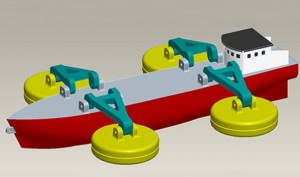Harvesting the ocean’s power for electricity isn’t a new concept, but a new tide-tapping ship is making waves at the forefront of the renewable energy industry. A European R&D organization called Fraunhofer Center for Manufacturing Innovation (CMI) is the brains behind the new vessel, dubbed simply the “Wave Crawler”.
The goal of the project is a cheaper, more flexible means of electricity generation and storage from tidal power. Traditional methods of harnessing oceanic energy are limited by immobile stationary structures, very expensive cables and wires, limited energy output and high overhead costs. The Wave Crawler could very well resolve almost every setback encountered with the previous methods.
The ship harnesses tidal power using a set of long, hinged arms with buoys on the ends. While it coasts about on the waves, the Crawler’s buoys bob up and down, in turn pivoting the arms like giant pistons. It is this piston-like motion that spins the turbines, generating renewable energy on board the ship at a rate of about 1 megawatt. From the generator, electricity is passed to an array of batteries where up to 20 Megawatt hours of power can be stored.
In order to max out the battery capacity on board, the Wave Crawler needs about a twenty-hour tidal tour. Once the ship has lapped up its fill, it can return to port and pass the electricity to the power grid. Early estimates put the cost-per-kilowatt-hour for this method at around 15 cents. That’s a huge difference, representing a savings of up to 50 cents per kwh over traditional methods for tidal power generation.
Not only is it cheaper, the Wave Crawler needs no mile-long cables or wires and the equipment is fully self-sustained on the vessel. The power can be stored for transmission any time and the ship’s mobility and flexibility puts it far ahead of the stationary methods presently in use. Mobility is a key benefit, not only for its logistical value, but also because it means exemption from regulatory obstacles that affect stationary structures.

